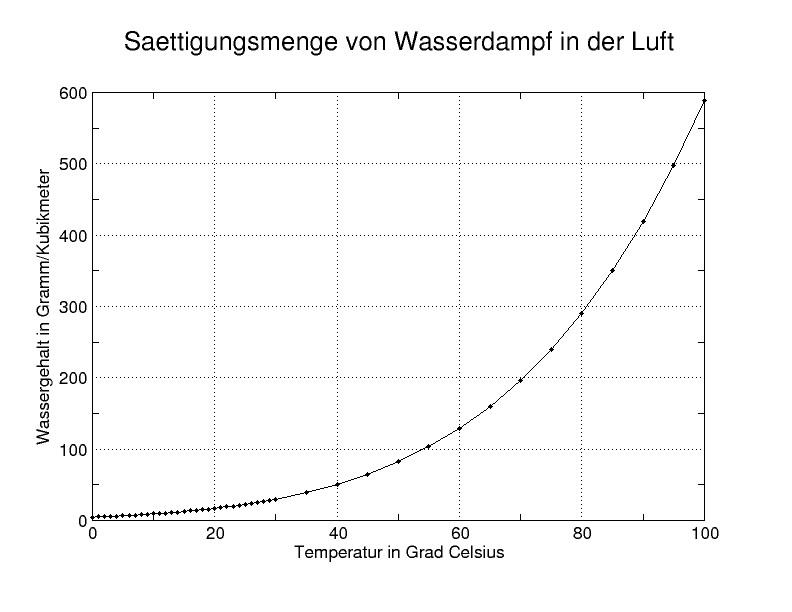Measured Variables
Author: Hans-Jürgen Schwarz
English Translation by Sandra Leithäuser
Back to Air Humidity Measurement
Abstract[edit]
The moisture content in air can be measured by its dew point, saturation humidity, relative humidity (RH), absolute humidity and the moisture level.
Dew point[edit]
The dew point temperature is the temperature at which air is saturated with water vapor. If there is a higher supply of water vapor condensation will take place. This can also occur if the air cools down (as then it will be supersaturated with moisture). The dew point temperature is equal to the water vapor saturation temperature and cannot exceed 100ºC at standard pressure.
Saturation humidity[edit]
Saturation humidity is the amount of water vapor contained in one cubic meter of air at a specific temperature.
Relative humidity[edit]
Relative humidity is the ratio between water vapor partial pressure (Pw) in the atmosphere and the maximum possible water vapor pressure, i.e., the water vapor saturation pressure (PS) at that same temperature [1].
| Relative humidity (RH) is the ratio of water vapor that is actually contained in the air, against the maximum possible mass of water vapor in the air.
|
Failed to parse (SVG (MathML can be enabled via browser plugin): Invalid response ("Math extension cannot connect to Restbase.") from server "https://wikimedia.org/api/rest_v1/":): {\displaystyle RH = 100\cdot\frac{P_W}{P_s(T)}[\text{\%}]}
The relative humidity, being a ratio, is a dimensionless quantity and is indicated by in %. Because the saturation pressure depends exclusively on the air temperature, the relative humidity is also temperature dependent. The relative humidity decreases as temperature increases and vice-versa.
Even at temperatures below the freezing of water (0°C/32°F) the air contains water vapor and ice can pass directly into the gaseous state by sublimation, as can be observed in winter when snow disappears although the temperature does not rise above its melting point. Similarly, at low temperatures water vapor can directly pass into the solid state by deposition (rime, graupel/ snow pellets).
| RF\T | 10°C | 20°C | 30°C | 50°C | 70°C |
| 10,00% | ± 0,7 % | ± 0,6 % | ± 0,6 % | ± 0,5 % | ± 0,5 % |
| 50,00% | ± 3,5 % | ± 3,2 % | ± 3,0 % | ± 2,6 % | ± 2,3 % |
| 90,00% | 6,3 % | ± 5,7 % | ± 5,4 % | ± 4,6 % | ± 4,1 % |
At temperatures below 0°C the water vapor pressure of liquid water (supercooled) is different to that of ice.
| Temperature [°C] | at 960 hPa at relative humidity: [g/m³] | at 1013 hPa [g/m³] | ||
| 100% r.F. | 80% r.F. | 50% r.F. | 100% r.F. | |
| 30 | 29 | 23,2 | 14,5 | 30,4 |
| 20 | 16,5 | 13,2 | 8,25 | 17,3 |
| 10 | 9,0 | 7,2 | 4,5 | 9,4 |
| 0 | 4,6 | 3,7 | 2,3 | 4,8 |
Mixing ratio[edit]
| The mixing ratio X or moisture level in [g/kg] represents the ratio of water vapor mass to the mass of dry air |
Failed to parse (SVG (MathML can be enabled via browser plugin): Invalid response ("Math extension cannot connect to Restbase.") from server "https://wikimedia.org/api/rest_v1/":): {\displaystyle RH = 100\cdot\frac{\text{Mass of water vapor in the atmosphere} }{\text{Mass of dry air}}[\frac{g}{kgAir}]}
Absolute humidity[edit]
The absolute humidity (AH) stands for the amount of water vapor that is contained in a given volume of air.
| Absolute humidity (AH) means the amount of water vapor that is actually contained in one cubic meter of air. |
Failed to parse (SVG (MathML can be enabled via browser plugin): Invalid response ("Math extension cannot connect to Restbase.") from server "https://wikimedia.org/api/rest_v1/":): {\displaystyle RH = 100\cdot\frac{\text{Mass of water vapor contained in the atmosphere} }{\text{Volume of humid air}}[\frac{g}{m^3}]}
The unit for absolute humidity is g/m3. Measuring the absolute humidity has the advantage that the actual amount of water, which is present (e.g. in a gas) is revealed, irrespective of the temperature.
The relationship between temperature, absolute humidity and relative humidity is represented in the Mollier-Diagramm .
In order to understand the true condition of humidity in the atmosphere, the temperature must be stated as well as the relative humidity, because of their interdependence.
Example: Air at 25 ºC can hold up to 23 g/m3 of water vapor maximum until saturation. If it only contains 11,5 g/m3, the relative humidity is at 50% RH.
The water vapor content of the air is not only dependent on air temperature, but also, to a lesser extent, dependent on the air pressure. The air pressure fluctuates with respect to weather conditions, the height of the measuring point above sea level and the latitude of the measuring site.
Weblinks[edit]
- ↑ http://de.wikipedia.org/w/index.php?title=Luftfeuchtigkeit&oldid=76890054 gelesen 29.07.2010
